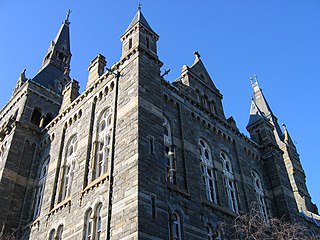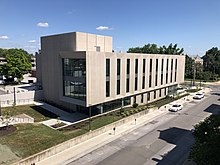
Emory Brace Remington (1892–1971) was a trombonist and music teacher. His unique method made him one of the most well-known and influential trombone educators in history. He was a member of the Rochester Philharmonic Orchestra from 1923 to 1949, and on the faculty of the Eastman School of Music in Rochester, NY from 1922 until his death in 1971.
The Marconi Radio Awards are presented annually by the National Association of Broadcasters (NAB) to the top radio stations and on-air personalities in the United States. The awards are named in honor of Guglielmo Marconi, the man generally credited as the "father of wireless telegraphy". NAB member stations submit nominations. A task force determines the finalists and the Marconi Radio Award Selection Academy votes on the winners, who receive their awards in the fall.

Wendell Castle was an American sculptor and furniture maker and an important figure in late 20th century American craft. He has been referred to as the "father of the art furniture movement" and included in the "Big 4" of modern woodworking with Wharton Esherick, George Nakashima, and Sam Maloof.

The Master of Arts in Liberal Studies or Master of Liberal Arts is a graduate degree that aims to provide both depth and breadth of study in the liberal arts. It is by nature an interdisciplinary program, generally pulling together coursework from a number of disciplines such as behavioral sciences, humanities, natural sciences, and social sciences designed to train students to think critically and contextually about their own fields of discipline as well a diverse range of issues. Similar graduate degrees are known as Master of Liberal Arts, Master of Liberal Studies (MLS), Artium Liberalium Magister, Magister Artium Liberalium, and Doctor of Liberal Studies (DLS). Characteristics that distinguish these degrees include curricular flexibility and interdisciplinary synthesis via a master's thesis or capstone project.
The National Association of Schools of Music (NASM) is an association of post-secondary music schools in the United States and the principal U.S. accreditor for higher education in music. It was founded on October 20, 1924, and is based in Reston, Virginia. The association's accreditation of schools of music began in 1939.
The Davis United World College Scholars Program is the world’s largest privately funded international scholarship program. It awards need-based scholarship funding, aka the Shelby Davis Scholarship, to graduates of schools and colleges in the United World Colleges (UWC) movement to study at 94 select partner universities in the United States.
Marco Breuer is a German photographer. Much of his work is undertaken without the aid of a camera, aperture, or film, being instead produced through a combination of photogrammic, abrasive, and incisive techniques.

Save America's Treasures is a United States federal government initiative to preserve and protect historic buildings, arts, and published works. It is a public–private partnership between the U.S. National Park Service and the National Trust for Historic Preservation. The National Endowment for the Arts, National Endowment for the Humanities, and Institute of Museum and Library Services are also partners in the work. In the early years of the program, Heritage Preservation and the National Park Foundation were also involved.
School of Public Health may refer to one or more of the following educational institutions offering instruction in public health or related fields:
William Quigley is an American painter from Philadelphia, Pennsylvania.
Raymond Harry "Ray" Brown is an American composer, arranger, trumpet player, and jazz educator. He has performed as trumpet player and arranged music for Stan Kenton, Bill Watrous, Bill Berry, Frank Capp – Nat Pierce, and the Full Faith and Credit Big Band.
Arts Schools Network (ASN) is a non-profit professional association founded in 1981.
Laylah Ali (born 1968) is a contemporary visual artist known for paintings in which ambiguous race relations are depicted with a graphic clarity and cartoon strip format.
The Journal of Neuro-Oncology is a peer-reviewed medical journal covering cancer of the central nervous system. It was established in 1983 and is published 15 times per year by Springer Science+Business Media. It was originally published by Martinus Nijhoff Publishers and has been published by Springer since 2005. It is the oldest continuously published journal focused on the field of Neuro-Oncology.
William E. F. Heeks, Jr., popularly known as Willy Heeks, is an American abstract expressionist painter.
Dawn Clements (1958–2018) was an American contemporary artist and educator. She was known for her large scale, panoramic drawings of interiors that were created with many different materials in a collage-style. Her primary mediums were sumi ink and ballpoint pen on small to large scale paper panels. In order to complete a drawing she cut and pasted paper, editing and expanding the composition to achieve the desired scale. Her completed drawings reveal her working process through the wrinkles and folds evident in the paper. She described her work as "a kind of visual diary of what [she] see[s], touch[es], and desire[s]. As I move between the mundane empirical spaces of my apartment and studio, and the glamorous fictions of movies, apparently seamless environments are disturbed through ever-shifting points of view."

Deborah Roberts is an American contemporary artist living and working in Austin, Texas. Roberts is a mixed media collage artist whose figurative works depict the complexity of Black subjecthood and explores themes of race, identity, and gender politics taking on the subject of otherness as understood against the backdrop of existing societal norms of race and beauty. Her work has been exhibited internationally across the US and Europe. Roberts’s work is in the collections of the Whitney Museum of American Art, New York; Brooklyn Museum, New York; The Studio Museum in Harlem, New York; and Los Angeles County Museum of Art, California. Roberts was named 2023 Texas Medal of Arts Award Honoree for the Visual Arts. Roberts was selected to participate in the Robert Rauschenberg Residency (2019) and is a recipient of the Anonymous Was A Woman Grant (2018), the Pollock-Krasner Foundation Grant (2016), and the Ginsburg-Klaus Award Fellowship (2014). She received her MFA from Syracuse University, New York. She lives and works in Austin, Texas. Roberts is represented by Stephen Friedman Gallery, London, and Vielmetter Los Angeles.





